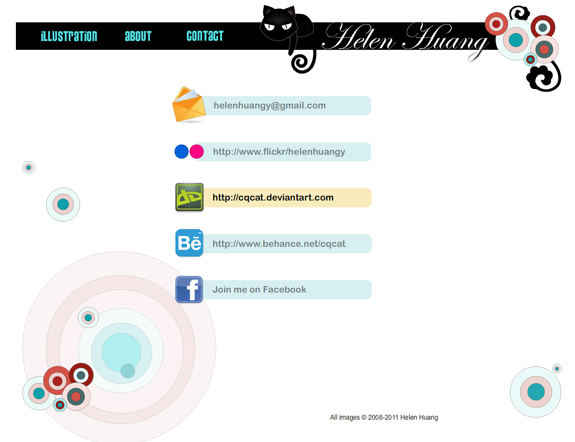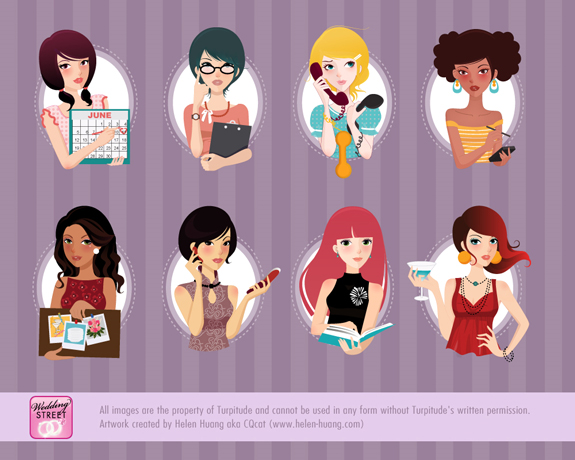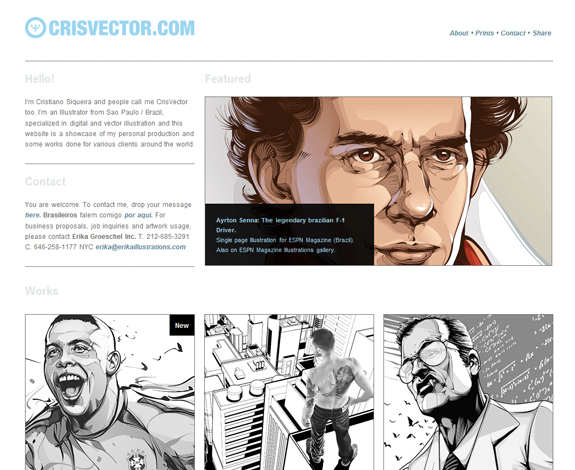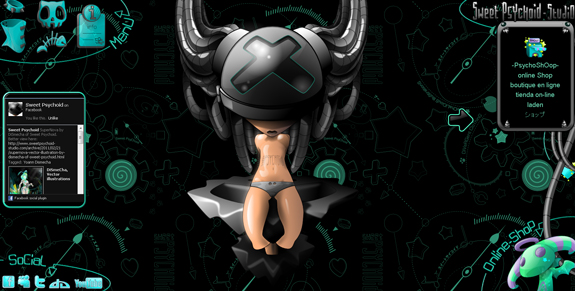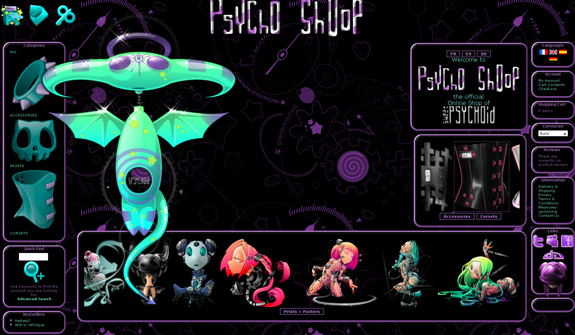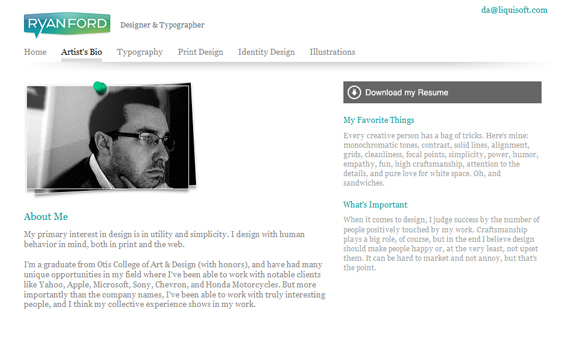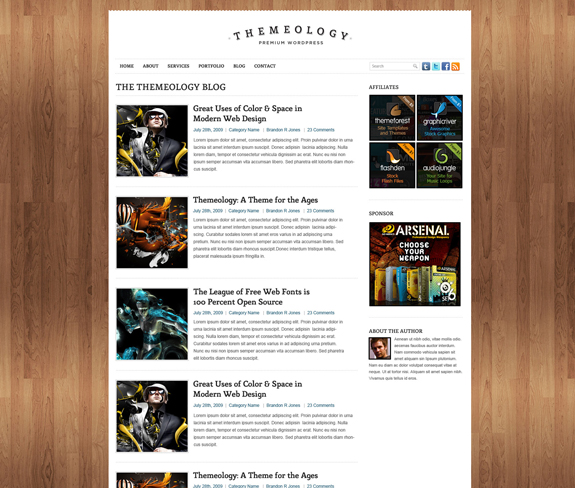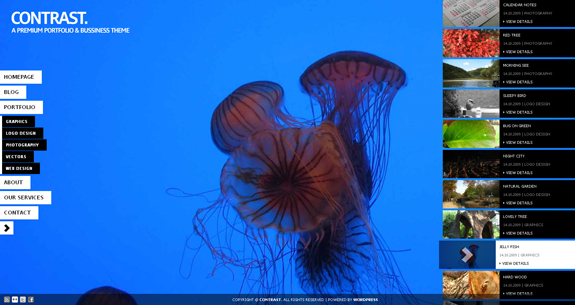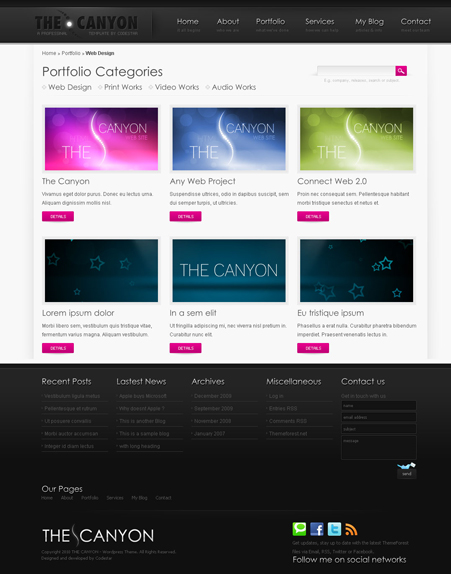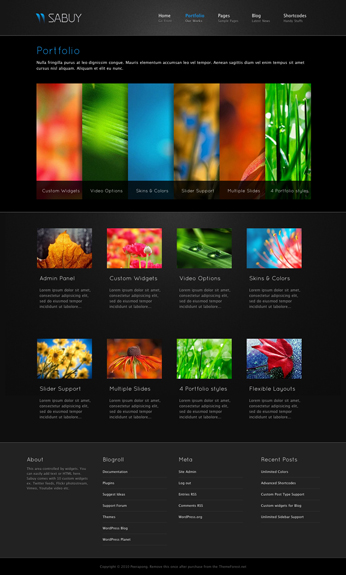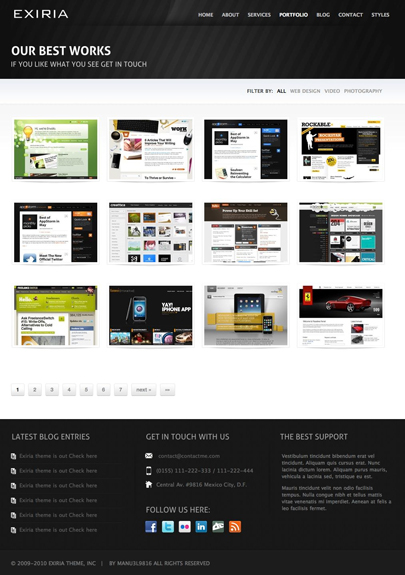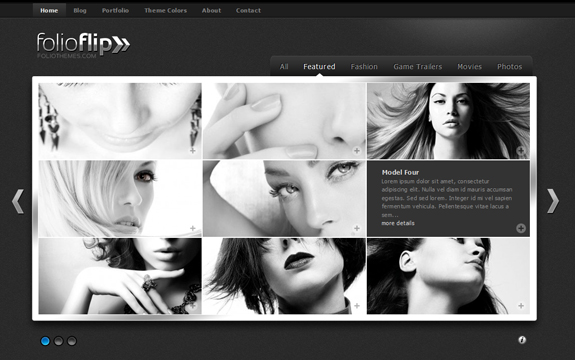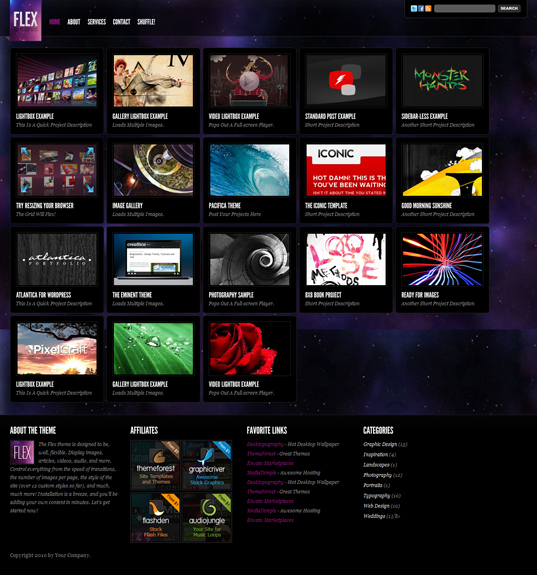So you’ve decided you want a portfolio, but aren’t sure what you want in it, or which route to go. Maybe you’ve just started out and have a low budget. In today’s article I look at starting a new portfolio with advice from vector artists and a look at two low budget portfolio options.
Introduction
When I started taking my work more seriously, I decided the right path for me to go to get my work out there more was to create a portfolio. Now almost a year down the line and with different things happening in my career, I feel it’s time to reassess my portfolio to cater to the audience I wish to please.
For changing any portfolio, I suppose one of the first questions you have to ask is what is your budget? When you’re first starting out, which I feel I still am, your financial resources may not be appealing to Mr. Amazing Webdesigner, so you need to take these things into your own hands, at least for now.
Portfolios and Vector Artists
In my research for this issue, I decided to ask some fellow vector artists about their portfolios and any tips they’ve learned along the way for constructing an effective portfolio.
Helen Huang aka CQCat
Q Should there be a limit on the amount of pieces you contain in your portfolio? If so, how many and how would you go about selecting the ones to feature?
I don’t think there needs to be a limit on the amount of pieces in your portfolio. However, I think there are two things that are very important and relevant. First, make sure all the work on your portfolio site is up to your current standard. If you have something from ten years ago that is obviously not as good as your work now, then I would not recommend putting it in your portfolio. Second, keep your portfolio fresh and current. You don’t want people to go there only to see your work from over a year ago. Chances are your recent work is better and improved. That’s what you want to showcase.
Q Within your portfolio, do you think it is good to stick with your primary style or should you show a variety of styles? And why do you think this?
In my opinion, it depends. If you plan to attract certain clientele or want to focus on certain style of work, then stick with that style on your site. If your portfolio site is to showcase your versatility, then obviously you want to show a variety of styles. A third solution I’ve also seen is to put your primary style under one section and the other styles under another section. In that way, people will understand that you specialize in a particular style, but are also capable of other styles.
Q What is your opinion on portfolio websites that also contain a blog element? Do you think this is a good idea?
I think it’s a fantastic idea to have a blog element on your portfolio site if you have the time to be a diligent blogger. I love checking out artists’ blogs to see what’s going on, their new works, sneak peeks of works in progress. I myself, would love to have that on my site if I had the luxury of time.
Q Is there any advice you would give people who are putting together their first portfolio? Is there anything they need to consider?
There are several things to consider before starting your first portfolio site:
First, know the purpose of your portfolio site. Are you trying to showcase your personality through your artwork or are you trying to attract corporate clients with a more professional look? The design of your site will most likely look very different depending on the purpose.
Second, you probably will be updating and adding new works to your portfolio site after you build it. An easy maintenance and update workflow will save you a lot of time later on. All my works are called in through XML, so all I have to do is update a few lines of code to add them to my site.
Last, make sure you have all the correct contact information on your portfolio site so people can find you. And it’s a good idea to link out to your facebook, twitter, deviantART page, and so on if you have them, so people can follow your work easily and be an active part of your fan base.
Cristiano Siqueira aka CrisVector
Q Should there be a limit on the amount of pieces you contain in your portfolio? If so, how many and how would you go about selecting the ones to feature?
No, I think the artist can show everything he wants. No limits. But, to keep the portfolio organizated and make the navigation easier and faster, it’s good to have a featured section where people can see the best works or the works that best represent what the artist can do. I think it’s good to have all the works in a kind of “archive” section, so everybody that wants to know more about the artist, can see the older works and see where the artist can go working in another style.
Q Within your portfolio, do you think it is good to stick with your primary style or should you show a variety of styles? Why do you think this?
I try to show some variation of styles, but I keep some highlight in the style that I believe I’m best with. The key is to suggest a style, but keep some other styles as an option in case the primary style is not the potential client’s favorite one.
Q What is your opinion on portfolio websites that also contain a blog element? Do you think this is a good idea?
I think it’s a good thing, but the blog element should be separated from the gallery with works, usually clients just want to see the works as fast possible. The blog element is good for the artist to say what he thinks, give explanations for the works, cases and share information. It’s like a way to meet and know learn about the artist.
Q Is there any advice you could give people who are putting together their first portfolio? Is there anything they need to consider?
First, I think the artist needs to know what kind of client he wants to reach, this is very important to select the most relevant pieces for the featured works section. Also, it’s better when the navigation is easy, fast and has a quick access to the works. It’s important to have in mind that all the people don’t have patience to be on a website, they leave an unknown website in seconds if you don’t give reasons to be there. Displaying part of your work directly on the home page is a way to catch attention and make the client sure that he is in the right place.
Dismecha
Q Should there be a limit on the amount of pieces you contain in your portfolio? If so, how many and how would you go about selecting the ones to feature?
I don’t think there should be a limit, it just has to be well organized with a thumbnail view if possible. Having several portfolios is also a solution if you have to divide your work.
Q Within your portfolio, do you think it is good to stick with your primary style or should you show a variety of styles? Why do you think this?
I think it depends on what you’re planning for your own future.
Do you want to get commissioned on a certain style? If so, then sitck with it and show how you are comfortable with it. Your clients are based on what you show anyways.
Q What is your opinion on portfolio websites that also contain a blog element? Do you think this is a good idea?
It depends on the purpose of your portfolio. As an original artist, if you want to interact directly with your viewer, having blog elements can be helpful since it makes it very dynamic and easy to use (i.e leaving a comment, share it on other social networks, etc.).
If you want to work for companies, then I think it’s certainly not welcomed: your client just wants to see your skills and experience in a formal way, they know what they’re looking for and what you’re capable of just by looking at your work.
Q Is there any advice you would give people who are putting together their first portfolio? Is there anything they need to consider?
The questions you’ll have to answer first are: Who will be the viewer of this portfolio? Why would a client or company would commission you instead of another? Your portfolio is here to attract your future clients.
Ashley Benson aka PixelledAndDead
Q Should there be a limit on the amount of pieces you contain in your portfolio? If so, how many and how would you go about selecting the ones to feature?
I think there should definitely be a limit to how many pieces are being offered to the client as a reference of your latest work. How many of us get overly excited and try to jam as much work into a folder as possible? It’s kind of inevitable that we try to splash every nook and cranny with our work, especially since we’re all vying for that “big” make it or break it job/commission.
Having a set limit really forces us to take a more critical look at what we are presenting in our portfolios. We don’t want them to be glorified digital sketchbooks, but rather a culmination of our latest accomplishments. They are there to impress, so dress them to do just that.
Q Within your portfolio, do you think it is good to stick with your primary style or should you show a variety of styles? Why do you think this?
I think it’s nice to go into a variety of work, if you have it, and if it still meets to the standard you’ve set with your other work. I personally feel that if you’re content in showing your “different” work, then by all means, but ask yourself whether or not you’re comfortable working in that particular style in a much larger extent. Chances are that if it catches the eye of your potential client, they’re going to want the sun, the moon, and the stars, but at radioactive proportions.
If you think that this style isn’t worth the effort to enhance, then keep it out of your portfolio. It’s best to turn their attention to your strongest work, especially since it’s probably what caught their eye in the first place. Sometimes, a roving eye in your portfolio isn’t such a great thing, keep them focused on your strongest attributes.
Q What is your opinion on portfolio websites that also contain a blog element? Do you think this is a good idea?
I personally don’t have a blog alongside my web portfolio, and I doubt I’d really want one alongside my work. To take the definition from blogger.com, a blog is defined as: “a personal diary. A daily pulpit. A collaborative space. A political soapbox. A breaking-news outlet. A collection of links. Your own private thoughts. Memos to the world.”
If you think about your portfolio sitting next to your “diary,” that would make it feel less professional in my opinion. No potential client in their right mind wants to know about your break up with “Mr. Victor Vector,” or that your toast was extremely burnt yesterday due to the overload of clothes your were folding after doing laundry.
Having blogs can be a positive experience, but I don’t think they really belong anywhere close to your “money maker.” It’s so easy to blurt out that little sentence you didn’t want your potential clients to know about, or the flaming you’ve decided to give your previous employer. This kind of thing reflects on you as a “product producing machine.” Whatever information you’re freely giving out to your audience, will either strengthen or hurt their opinion of you and your work ethic. Regardless of whether you have a blog element, all I’m saying is, “keep it classy.”
Q Is there any advice you would give people who are putting together their first portfolio? Is there anything they need to consider?
Well I would consider using DeviantArt‘s portfolio option to start your first portfolio. While you’re building your new shiny website, why not at least have an actual already functioning one up for your client’s disposal?
I’m still in the thinking stages of putting an actual website together, and I utilize my dA portfolio to the fullest. I’ve successfully gotten several jobs from sharing a link to my portfolio hosted by DeviantArt, and I can’t be more grateful to the site for making it so simple to build. It’s easy, convenient, and builds in a blink.
They also have a respectable cut off number for work that you can upload to your portfolio which actually helps you weed out your best pieces. You’re allowed around 80 pieces, so I think that’s pretty fair.
Whereever one might go to make their portfolio, just keep in mind that it’s not about you. You’ve seen your work, you already know how awesome you are, so now you have to prove it and show what kind of asset you can be for your potential client. However you display your work, make sure it’s simple to navigate through and cleanly displayed. Glitter and fireworks are nice, but your client isn’t hiring you for the elaborateness of your portfolio look. They’re there for your artwork, so make them first and foremost in your display.
DeviantART Portfolio’s – A Free Alternative?
As an active deviantART member and after seeing a talk from Ashley Benson, I decided to look into this option more.
Back in the Summer of 2009, deviantART announced their Free Portfolio feature as part of the standard account with additional benefits for those who have a subscription. For those with absolutely no financial resources, this appears to be a very good option, especially since there are no advertisements or in your face branding!
From accessing my own account, it was a case of ticking a few boxes, filling in a couple fields and there we have a portfolio within about 30mins to an hour. There are many color and layout options available giving you choice to tailor your “dAfolio” to suit your body of work.
The best thing about it is that there are no hosting costs involved and you don’t need to know CSS and HTML! This is definitely appealing, even if it’s a temporary option until you do have the financial resources to make a more unique looking portfolio.
To find out more about this option, check out the following news article on deviantART. It’s worth saying that to register an account for deviantART is completely free!
ThemeForest WordPress Templates
The free portfolios at deviantART are appealing, but what if you want more control over your portfolio? You might want to modify sections of it or include more content than just images. This is something that I personally want for my future portfolio. This is where WordPress may come in handy.
The start out costs are minimal if you consider under $40 USD for a professionally designed WordPress template, domain name and hosting… after that you’re in control of your website and can modify it to your hearts content. The beauty of WordPress is that once you’ve set up your website, adding additional content can be done with ease via the admin system provided!
My primary port of call has been ThemeForest, as they have a large variety of professional portfolio designs. After combing through hundreds of WordPress designs, I’d like to share with you my favourite 10 designs, all for under $40 USD each.
Themeology By Epicera
Contrast By Themolution
Creative Zodiac By Freshface
Personal Landing Page By Mixey
The Canyon By Codestar
Sabuy By Peerapong
Exeria By Manu3l9816
Folio Flip By MLando
Pixelcraft By Epicera
Flex By Epicera
Conclusion
With the advice given from vector artists working in a variety of areas on portfolios, and looking at a couple options available for my small budget, I can see which route I want to go. Although there are different routes out there and they will cater for different people, I certainly find the WordPress option as one I’d like to go down, if only for having more control over my site.
Do you have a portfolio? What advice would you give to someone who is just starting out and wanting to find out more about creating a portfolio? Are you looking to create a portfolio? Which route are you wanting to go? We’d love to know!

